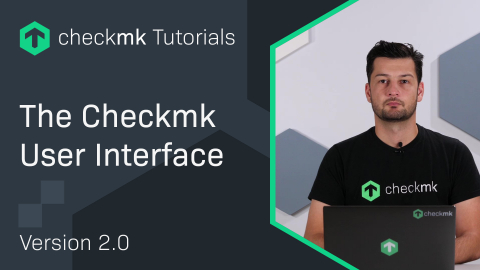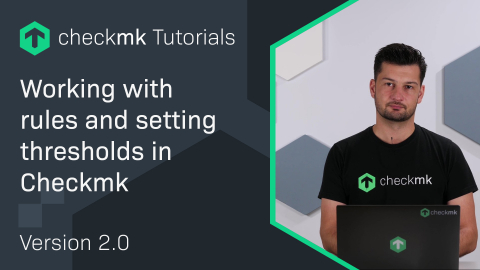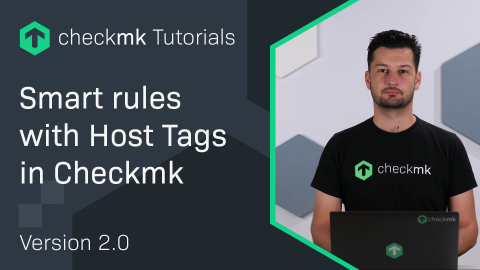Ep. 1: Installing Checkmk 2.0 and monitoring your first host
| [0:00:00] | Hi, my name is Baris from the Checkmk team and welcome to this tutorial series on "Getting started with Checkmk". In the next 17 episodes, we're going to install and configure Checkmk as your monitoring system we will also cover topics such as monitoring SNMP, customizing and creating your own views, distributed monitoring and much more. |
| [0:00:22] | Now, Checkmk comes in a few editions we got the open-source edition which is free to use for everyone, then there is an enterprise edition which is based on our proprietary monitoring core and has many additional features around automation and reporting, and it's also very suitable for monitoring large IT environments. |
| [0:00:41] | Then there is a free version of this enterprise edition which has all the same features but will be limited to 25 hosts after 30 days. |
| [0:00:50] | So even after 30 days, you can still monitor up to 25 servers, SNMP devices or whatever you like. |
| [0:00:58] | Now we'll be using the free version of the enterprise edition throughout the series, so now let's get started with Checkmk. |
| [0:01:15] | So in this first episode, we're going to install Checkmk and we're also going to add our first host to the monitoring system. |
| [0:01:22] | To install Checkmk you are going to need a Linux environment I prepared a VM with Ubuntu 20.04 installed. Now the first thing we are going to have to do is download Checkmk. To do that let's open a browser and go to checkmk.com. So navigate to checkmk.com. Once you're on the home page click on the download button in the top right. Now you'll see that the free edition is already pre-selected for you, so what you have to do next is select the platform in my case that will be Ubuntu and the version of Ubuntu that I have installed is 20.04 so let's select that. |
| [0:01:58] | Now we ask for an email address so we can send you some tips on how to get started with Checkmk. |
| [0:02:09] | Once you have put in your email address, hit the big green download button and wait for the download to finish. |
| [0:02:22] | Once the download is complete let's head over to the terminal and copy over the file to our VM. So here you see we have the file now let's just simply copy it over to our VM. Let's copy the file name, and we'll copy it over to our VM. |
| [0:02:49] | We'll put it in the tmp folder for now. Okay, it's done now let's ssh into the VM and get started with installing Checkmk. Okay, we have put it in the tmp folder so it's here. So now we can simply install Checkmk using "apt install" this will install Checkmk with all its dependencies. |
| [0:03:27] | So what is a dependency? |
| [0:03:28] | Checkmk comes with its own version of Apache, PHP and Python. And all these versions are marked in the package, and once you run "apt install", everything will be installed for you. Okay, so let's install it using "apt install", so you see all these dependencies will be installed once I press "yes". |
| [0:04:08] | Okay, so the installation is complete. Let's check the version. Okay, you see that we installed version 2.0 patch level 9. So now the next thing to do is create our first monitoring site. |
| [0:04:25] | So what is a site? A site is basically an instance of Checkmk. And you can have multiple of these sites or instances running in parallel on the same system, and is especially useful when you have for example a production environment but you want to test out a new version of Checkmk you can simply create a new site. |
| [0:04:43] | Okay so now let's create a first site type in "omd create" followed by the name of the site I will call it "test_site" because it's for test purposes, but you can name it however you want. |
| [0:05:02] | So what's happening now it will create the place on a file system to store all the data, it will create a linux user for the site and it will also create our first admin user called "cmkadmin" and generate a password. So let's copy this password to the clipboard. |
| [0:05:21] | Now when you create a site it's not actually being started yet. So type in "omd status" and you can see that it's not running. |
| [0:05:31] | So to start the site type in "omd start" followed by the name of the site "test_site". And if everything is okay you can switch over to the browser and visit the UI. So let's do that. |
| [0:05:49] | Now to visit the UI, type in the IP of your server or VM, followed by a slash ( / ) and then the name of the site. |
| [0:06:06] | Now the default user is "cmkadmin", type that in, and paste in the password that's been generated. |
| [0:06:14] | Now once you log in for the first time, you'll see that the dashboard is pretty empty. That's because we're not actually monitoring anything. |
| [0:06:23] | First, let's quickly change the password, so click on "User" in the bottom left and change password, paste in again the password and type in your new password. Hit save. |
| [0:06:40] | Okay now, let's head back to the main dashboard by clicking the logo on the top left. |
| [0:06:49] | Okay, let's quickly talk about the right sidebar so this is the overview you here you will see how many hosts are being monitored, and how many services but you can also, see if there is any problems. Right now it's still completely empty, so let's quickly change that. |
| [0:07:06] | So the first thing we are going to monitor is the monitoring server itself. To do that we will need to install an Agent. |
| [0:07:14] | We will install this agent on the server and that will send the data to our monitoring server. So click on Setup. |
| [0:07:25] | And then go to "Agents" and click the first item. Now here you'll see all the different agents that we have. |
| [0:07:32] | So we have an agent for Windows, for Red Hat, for Debian, for Solaris, for AIX and if you want to monitor something more exotic then there is this TGZ file you can download. |
| [0:07:49] | But we have an ubuntu 20, so let's download the Debian file. |
| [0:07:54] | So once that is done downloading, let's switch back to the terminal and copy it over to our VM, now let's log out of the VM quickly. |
| [0:08:04] | Okay, you'll see here that we have the agent let's scp that over again or again scp followed by the file name, again to the tmp folder. Okay, that's done let's log back in. |
| [0:08:42] | Okay so once again we can use "apt install" to install the agent it should be fairly quick. Okay and that's it. We're all set up, we can now add the host to the monitoring system. So let's switch back to the browser and add it to Checkmk. |
| [0:09:07] | To add the host to the monitoring system, once again click on setup and then go to "Hosts", and then "Add host", you can either click the small button or the big blue button here. Now what we need to do is give it a hostname. |
| [0:09:22] | I will call it the "monitoring_system" and that describes it fairly well, but you can name it basically whatever you want. |
| [0:09:33] | In my case, I will also need to add an IP address because I don't have a fully qualified domain that's resolvable by DNS otherwise I could have given that in and then, you can omit the entire IP address and it will just resolve itself. |
| [0:09:54] | Okay, that's it, now click on "Save" and go to service configuration and you will see that it will already start discovering services that are being sent from the agent. |
| [0:10:06] | So now you'll see that everything is undecided we're not actually monitoring anything. We have not decided if we want to monitor this specific service. |
| [0:10:16] | So you can either go through this list by clicking the "+" or the "x". If you click the "+" you can monitor the service, if you click the "x" then you basically don't want to monitor the service and it won't show up. |
| [0:10:31] | I will click on "Fix all" and it will just monitor everything. |
| [0:10:39] | We'll still have one undecided let's click the "+". Okay so now we're monitoring all the services that are being sent over the agent. |
| [0:10:52] | And you see here that we have a few changes. |
| [0:10:55] | Whenever you make a change to the setup of Checkmk, it will show up here that there are changes. Changes are not being applied automatically, but only if you explicitly activate them then they will be applied to the monitoring system. |
| [0:11:12] | So here you see the pending changes you see everything that we have done. |
| [0:11:16] | We have created a new host, we have discovered the labels that came with some of the services and we are now monitoring 23 services for this host. |
| [0:11:29] | So if we click on "Activate on selected sites", it will be applied. |
| [0:11:37] | Okay so the changes have been activated and applied to the system, now let's look at the top right, you'll see now that we have our first host and it has 26 services. |
| [0:11:48] | If you click on the number here, you'll go to an overview where you see all the hosts in your system. We currently have one, so click on the name here and you'll get to an overview of all the services that come with this host. |
| [0:12:01] | Let's collapse the sidebar so we can see a little bit more. |
| [0:12:06] | Now, here you'll see stuff like the CPU load, the CPU utilization the room left on the filesystem, the memory. But let's click on one and see what information we see. |
| [0:12:21] | So here you'll see some data like here you see the CPU utilization over time. We only added the host a few seconds ago, so there is not much data to show, but over time you'll see more and more here. |
| [0:12:34] | You can find all the information on Checkmk online on our documentation. If you click help and then on the "User Guide", you'll be redirected to our |
| [0:12:43] | documentation website. If you're new to Checkmk, I can highly recommend the beginner's guide. |
| [0:12:49] | Here, we explain step by step, how to get started with Checkmk. |
| [0:12:54] | So that was it for today if you run into any problems while installing Checkmk, head over to forum.checkmk.com and our community members will be happy to help you out. If you're looking for a more interactive introduction to Checkmk you can sign up for a free webinar you can find the link in the description of this video. If this video was helpful to you, please subscribe to the channel and give a like to the video. |
| [0:13:18] | See you in the next episode. |
Interested in learning more? Register for a dedicated Synthetic Monitoring training course.







